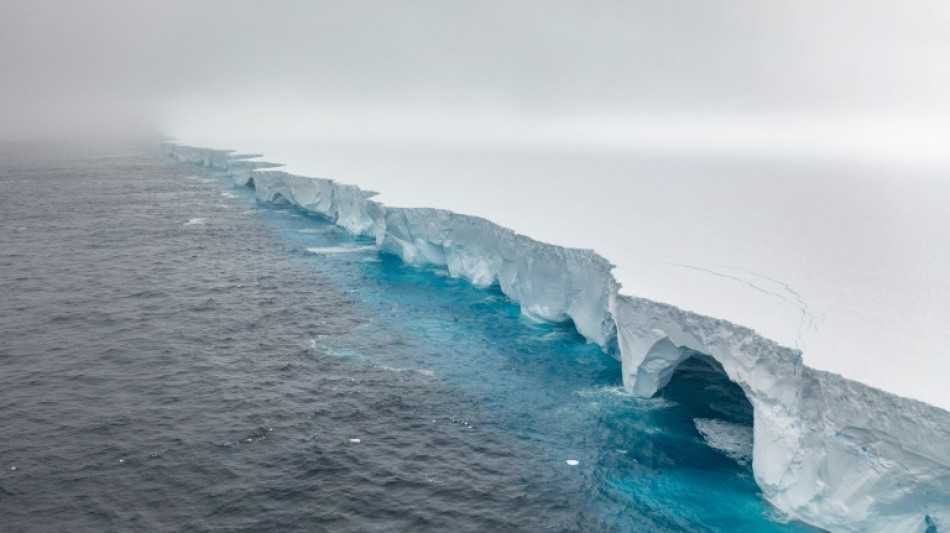
-
 Amazon says blocked 1,800 North Koreans from applying for jobs
Amazon says blocked 1,800 North Koreans from applying for jobs
-
Trump says US needs Greenland 'for national security'

-
 Purdy first 49er since Montana to throw five TDs as Colts beaten
Purdy first 49er since Montana to throw five TDs as Colts beaten
-
North Korea's Kim tours hot tubs, BBQ joints at lavish new mountain resort

-
 Asian markets rally again as rate cut hopes bring Christmas cheer
Asian markets rally again as rate cut hopes bring Christmas cheer
-
Australian state poised to approve sweeping new gun laws, protest ban

-
 Trapped under Israeli bombardment, Gazans fear the 'new border'
Trapped under Israeli bombardment, Gazans fear the 'new border'
-
Families want answers a year after South Korea's deadliest plane crash

-
 Myanmar's long march of military rule
Myanmar's long march of military rule
-
Disputed Myanmar election wins China's vote of confidence

-
 Myanmar junta stages election after five years of civil war
Myanmar junta stages election after five years of civil war
-
Ozempic Meals? Restaurants shrink portions to match bite-sized hunger

-
 'Help me, I'm dying': inside Ecuador's TB-ridden gang-plagued prisons
'Help me, I'm dying': inside Ecuador's TB-ridden gang-plagued prisons
-
Australia's Cummins, Lyon out of fourth Ashes Test

-
 US singer Barry Manilow reveals lung cancer diagnosis
US singer Barry Manilow reveals lung cancer diagnosis
-
'Call of Duty' co-creator Vince Zampella killed in car crash

-
 Decentralized Masters Announced as the Best Crypto Course of 2025 (Courses on Cryptocurrency Ranked)
Decentralized Masters Announced as the Best Crypto Course of 2025 (Courses on Cryptocurrency Ranked)
-
Trump says would be 'smart' for Venezuela's Maduro to step down

-
 Steelers' Metcalf suspended two games over fan outburst
Steelers' Metcalf suspended two games over fan outburst
-
Salah, Foster take Egypt and South Africa to AFCON Group B summit

-
 Napoli beat Bologna to lift Italian Super Cup
Napoli beat Bologna to lift Italian Super Cup
-
Salah snatches added-time winner for Egypt after Zimbabwe scare

-
 Penalty king Jimenez strikes for Fulham to sink Forest
Penalty king Jimenez strikes for Fulham to sink Forest
-
Kansas City Chiefs confirm stadium move

-
 Liverpool rocked by Isak blow after surgery on ankle injury
Liverpool rocked by Isak blow after surgery on ankle injury
-
US stocks push higher while gold, silver notch fresh records

-
 Deadly clashes in Aleppo as Turkey urges Kurds not to be obstacle to Syria's stability
Deadly clashes in Aleppo as Turkey urges Kurds not to be obstacle to Syria's stability
-
Is the United States after Venezuela's oil?

-
 Trump admin halts US offshore wind projects citing 'national security'
Trump admin halts US offshore wind projects citing 'national security'
-
Right wing urges boycott of iconic Brazilian flip-flops

-
 From misfits to MAGA: Nicki Minaj's political whiplash
From misfits to MAGA: Nicki Minaj's political whiplash
-
Foster grabs South Africa winner against Angola in AFCON

-
 Russia pledges 'full support' for Venezuela against US 'hostilities'
Russia pledges 'full support' for Venezuela against US 'hostilities'
-
Spotify says piracy activists hacked its music catalogue

-
 Winter Olympics organisers resolve snow problem at ski site
Winter Olympics organisers resolve snow problem at ski site
-
Fuming Denmark summons US ambassador over Greenland envoy

-
 UK's street artist Banksy unveils latest mural in London
UK's street artist Banksy unveils latest mural in London
-
Rugby players lose order challenge in brain injury claim

-
 UK singer Chris Rea dies at 74, days before Christmas
UK singer Chris Rea dies at 74, days before Christmas
-
Last of kidnapped Nigerian pupils handed over, government says

-
 Zambia strike late to hold Mali in AFCON opener
Zambia strike late to hold Mali in AFCON opener
-
Outcry follows CBS pulling program on prison key to Trump deportations

-
 Sri Lanka cyclone caused $4.1 bn damage: World Bank
Sri Lanka cyclone caused $4.1 bn damage: World Bank
-
Billionaire Ellison offers personal guarantee for son's bid for Warner Bros

-
 Tech stocks lead Wall Street higher, gold hits fresh record
Tech stocks lead Wall Street higher, gold hits fresh record
-
Telefonica to shed around 5,500 jobs in Spain

-
 McCullum wants to stay as England coach despite Ashes drubbing
McCullum wants to stay as England coach despite Ashes drubbing
-
EU slams China dairy duties as 'unjustified'

-
 Italy fines Apple nearly 100 mn euros over app privacy feature
Italy fines Apple nearly 100 mn euros over app privacy feature
-
America's Cup switches to two-year cycle


World's biggest iceberg 'battered' by waves as it heads north
It was impossible to see through the snow and fog on the Antarctic seas but expedition leader Ian Strachan knew his ship was approaching a true behemoth: the world's biggest iceberg lay somewhere ahead.
"Then the clouds lifted and we could see this expansive -- almost abstract -- white line that extended each way across the horizon," he told AFP.
As the ship got closer during its visit on Sunday, huge gaping crevasses and beautiful blue arches sculpted into the edge of the iceberg came into focus.
Waves up to four metres (13 feet) high "smashed" and "battered" its wall, breaking off small chunks and collapsing some arches, Strachan said.
He compared sailing along the endless jagged edge to looking at sheet music. "All the cracks and arches were different notes as the song played."
The tooth-shaped iceberg named A23a is nearly 4,000 square kilometres (1,550 square miles) across, making it more than twice the size of Greater London.
After three decades stuck to the Antarctic ocean floor, the iceberg is now heading north on what could be its final journey.
It contains an estimated one trillion tonnes of fresh water that is likely to melt off into the ocean along way.
The iceberg, which is up to 400 metres thick in places, is currently drifting between Elephant Island and the South Orkney islands.
- 'Magical' -
Strachan was speaking to AFP as his ship, run by the expeditions firm EYOS, was wrapping up a private tour of the Antarctic Peninsula.
It had been planning to go to South Georgia island but due to a bird flu outbreak there, it visited A23a instead.
It was not the first ship to witness the majesty of the iceberg.
The UK's RRS Sir David Attenborough was travelling to Antarctica on a scientific mission last month, when it found the A23a blocking its path.
Andrew Meijers, the chief scientist on board, said that when they approached the iceberg, the mist parted, the sun came out and a pod of orcas even swam past.
"It was really magical," Meijers told AFP.
"It took us six hours to steam past it," he added.
A23a first broke off the Antarctic coast back in 1986, making it the world's oldest iceberg, as well as its largest.
But it quickly became stuck to the ocean floor, where it languished for decades.
Andrew Fleming of the British Antarctic Survey told AFP that in 2020 he saw satellite images suggesting it was "wobbling".
Then late last year, A23a broke free from its icy shackles and started venturing north.
Whether or not this was caused by climate change -- winter Antarctic sea ice reached its lowest level on record last year -- remains an open question.
Fleming emphasised that these icebergs are a natural process, adding that one or two big ones break off every year.
"It's more likely that it's time had just come," he added.
But he emphasised that such icebergs are "part of a huge system that is changing dramatically".
- 'Lumbering beast' -
This "lumbering beast" moves slower than walking pace, Fleming said.
"The Titanic would've spotted this one coming."
Since breaking free, A23a has followed roughly the same path as previous massive icebergs A68 and A76, moving past the east side of the Antarctica Peninsula through the Weddell Sea along a route called "iceberg alley".
As the iceberg is "ejected out into the Southern Ocean", warmer waters and bigger waves will start to break it up, Fleming said.
If it follows the path of the two comparably huge previous icebergs, it will travel northeast towards the island of South Georgia, a haven for wildlife including penguins and seals.
There is a slight fear that if the iceberg parks itself near the island, it could block these animals from getting to where they normally forage, threatening their ability to feed themselves.
But this is not expected to happen.
A68 instead broke up into smaller chunks, causing a problem not for animals but humans, making it difficult for fishing ships to navigate the area, Meijers said.
A more likely path would be for A23a to move around the island and continue meandering northwards.
A rare few icebergs have made it so far that they have been spotted from the Brazilian coast.
But eventually A23a will meet the fate of all icebergs that journey north -- melting away in warmer waters.
"Ultimately, they're doomed," Fleming said.
M.A.Colin--AMWN



